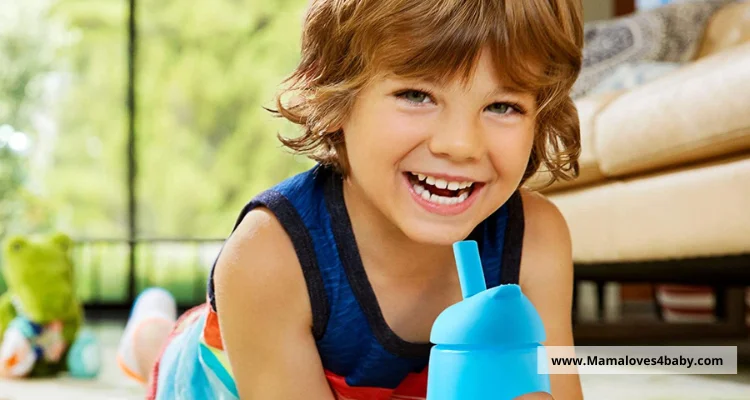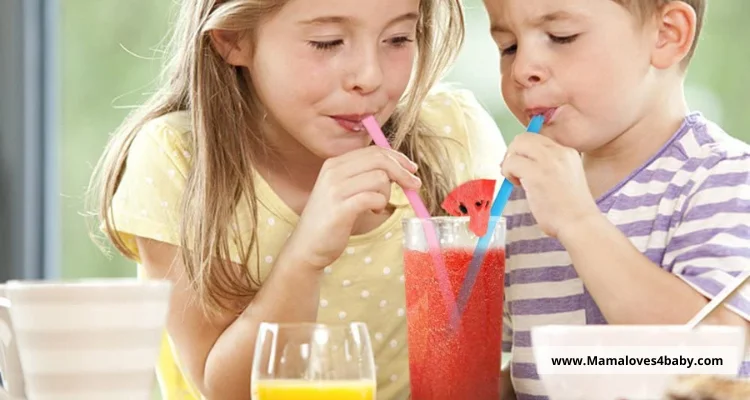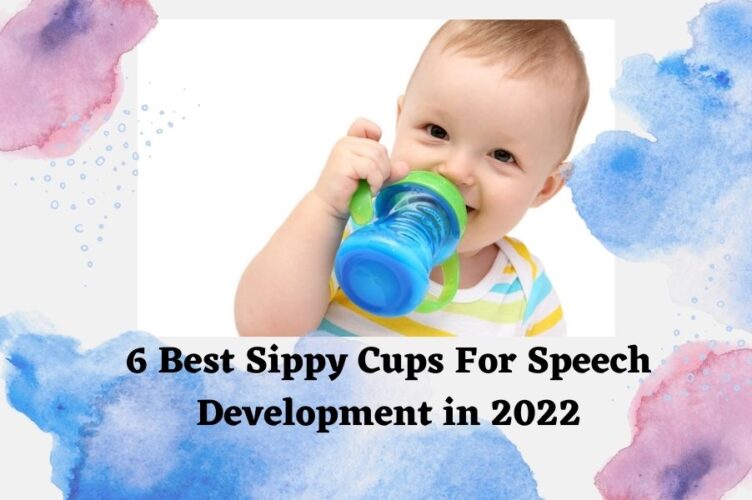Most parents worry about when their baby can start using a straw. After all, it’s one more step on the road to independence!
The ability to drink from a straw is a skill that develops over time. Babies typically start using a straw around 6-9 months old, but some may be earlier or later. According to a feeding specialist, let’s explore how and when can babies use straws.

When Can Babies Use Straws?
According to pediatricians, babies learn to use straws around six months old as infants have developed the coordination and strength to suck from a straw at this age.
Until then, they may be able to suck on the straw due to a strong sucking reflex, but they won’t be able to form a good seal around it with their lips and cheeks. It can make drinking from a straw difficult and result in them taking in more air than liquid.
So, at the start, you can offer a typical sippy cup, followed by an open cup and a weighted straw cup. Offer your baby a straw when you feed them breast milk or formula and see if they can drink from it successfully. If not, don’t worry – they’ll learn soon enough!
However, you should remember these tips when giving your baby a straw for the first time.
What is a good straw sippy cup for babies?
Many different types of straw cups are available for babies, and the best one for your child will depend on their individual needs. Some straw cups are designed to be easy for small hands to grip, while others have features that make them more spill-resistant. You may also want to consider how easy the cup is to clean, as some straw cups can be difficult to clean thoroughly.
Honey Bear Straw Cups
If you’re looking for a straw cup for your baby, you may wonder when they can start using one. Honey bear cups are a popular option of training cups for parents, but there are a few things to consider before making the switch.
One of the great features of the Honey Bear training cup is that you can use it with or without a straw. For babies who are just learning to use a straw, the built-in valves will help prevent spills. And when your baby is ready to transition to an open cup, the valves can also be removed for easy cleaning. The honey bear cups are durable and dishwasher-safe to last through all your child’s milestones.
If you’re considering a honey bear drinking cup for your baby, there are a few things to keep in mind.
- First, these cups can help with tooth development and reduce the risk of cavities.
- They’re also a good option for children learning to drink from a cup, as they can help transition from bottle feeding.
However, straw cups can be a little more challenging to clean than other options, so you’ll need to be extra careful. Additionally, your baby may end up taking in a mouthful of air if you’re not careful, which can lead to discomfort.
Why Love:
- Straw cups can help to teach straw drinking, which can be a significant milestone.
- They can also help tooth and baby’s gums development and reduce the risk of cavities and tooth decay.
Why Avoid:
- Some parents find straw cups a little more challenging than sippy cups to clean than other options.
- If you’re not careful, it can cause discomfort to your baby.
Step-by-Step Guide: when can a baby drink from a straw?
Generally, when your baby reaches 6 months of age, their hand coordination develops, and it will ease their transition from bottle to cup drinking.
But, if your babies and toddlers are having trouble, try placing the straw closer to their mouth or using a softer straw. You can also try using a sippy cup with a soft spout or a straw attachment. If your baby is still struggling, consult your pediatrician.
Develop straw drinking skills:
You can start introducing a straw between 4 and 6 months old once your baby can sit up well on its own. If you’re using a sippy cup, you can try one with a built-in straw or soft spouts. Or, you can purchase a regular straw and cut it to fit your baby’s sippy cup.
According to the American dental association, sucking on a straw can help your baby
- develop their oral muscles
- learn how to control the movement of their tongue
- improve their coordination
These skills are essential for later developmental toddler years, including speech.
When using a straw, be sure to:
- Help your baby hold the cup, so the straw is in the correct position.
- Show your baby how to suck on a straw to get the liquid out.
- Start with a few sips, so your baby doesn’t get too frustrated.
- Encourage your baby to take breaks between sips.
If your baby is having trouble with straw drinking, don’t worry. They will take some time. Just keep offering opportunities for your baby to practice, and they’ll get it eventually.
Transitioning from a bottle to a straw cup
Can a 6 month old drink from a straw? Yes, your baby will be interested in solid foods at around 6 months old. According to feeding therapists, you can introduce a straw cup filled with water during meal times. And breast milk to help your baby get used to straw drinking. If you’re introducing solid foods, start with pureed fruits and vegetables. Once your baby can chew well, you can offer minced or chopped foods.
If your baby is having trouble using a straw cup, try these tips:
- Use a soft silicone, flexible straw for baby’s lips.
- Cut the tip of the straw to make a small hole.
- Put the straw in the cup at an angle so your baby can easily reach the liquid.
- Help your kids hold the cup and guide the straw to their mouths.
- Encourage your baby to take small sips.
How do you teach a baby to drink from a straw?
You can start by offering your child a straw cup with water or another minimal spillage beverage. Once they get the hang of sipping from the straw, you can slowly introduce other liquids like juice or milk.
It’s essential to ensure that the cup is always positioned upright, so your baby doesn’t swallow too much air. You can also try using a straw trainer, a sippy cup with a short straw designed to help babies to use a straw.
When do babies learn to drink from a straw?
Mostly babies can drink from a straw by the time they are 12 months old. To help them learn, you can start by letting them practice with the best sippy cup or a straw cup filled with water. You can also give them a straw to play with, so they can get used to feeling it in their mouth. Once babies are comfortable, you can give them a cup of juice or milk.
When to introduce an open cup
Some parents choose to do so as early as 6 months old, while others want to wait until their kid is a bit older, such as 9 or 10 months old or up to their first birthday. Ultimately, it will depend on your child’s individual development and readiness.
How to teach a baby to drink from an open cup
Before teaching the baby to drink from open cups, consider you have developed these milestones.
- Your child should be able to sit up relatively well on their own. It will help prevent spills and ensure your baby can drink from the cup without tipping it over.
- Your baby should have reasonable head control. It is vital for both safety and drinking purposes.
- Your baby should be able to coordinate their open mouth and tongue movements for drinking from sippy cups without spilling.
You can teach them open cup practice in a few other ways.
- Start by offering your small baby sips of water from an open cup. You can help guide the open cup to your baby’s mouth, but try to let them do as much on their own.
- Once your child drink water from an open cup, you can start giving them other liquids like milk or juice.
- Encourage your baby to take breaks often while drinking, and ensure they sit upright to help prevent spills.
Always remember that it may take a little while for your baby to use an open cup. Be patient and keep offering them opportunities to practice. With time and patience, your baby will be a pro at using an open cup in no time!

When to introduce straw cup
Likewise, after your baby starts drinking from an open cup, you can offer the straw cup to your little crawler. These are the little milestones that your child can achieve with age.
Since every baby develops differently and at its own pace, as a general rule of thumb, most babies can start using straw early, around 6-9 months old. You can teach baby to use a straw by offering soft straws with sips of water or other liquids. And then, you can gradually increase the amount of liquid and eventually move on to thicker drinks like smoothies.
If you’re concerned about your baby’s development, it’s always best to consult with a pediatrician. They can give you specific advice and let you know if your child is on track.
What to Put in a Straw Cup for a Baby
Many parents worry about what to put in a straw cup for their baby. While it is essential to ensure that your baby is getting enough liquids, you also want to be sure that they do not start drinking too much. The best way to determine how much liquid your baby needs is by using the recommended amount of ounces per day for their age group.
For example, a baby between the ages of 4 and 6 months old should drink about 4 to 6 ounces of liquid daily. You can use this amount to determine how much to put in a straw cup for your baby.
You should avoid giving juices to babies under 6 months old. If you want to give your child fruit juice, dilute it with equal water. After 6 months, you can offer small amounts of 100% fruit juice in a cup.
Avoid giving your baby sugary drinks, like sodas or sports drinks, as they contain high calories and can contribute to weight gain. Stick to water or milk as the main drink for your baby.
A detailed guide on Cleaning Your Straw Cups
Assuming you are using regular straw cups and not sippy cups with a valve, you will want to clean your straw cups after each use. If you use sippy cups with a valve, you will want to clean them at least once a week.
- To clean your straw cup, start by taking the cup apart.
- Remove the straw and the cap, and set them aside.
- Next, wash the cup itself with warm soapy water.
- Be sure to get into every corner and rinse them well.
- Now it’s time to clean the straw. Start by running it under warm water. If you have a thin straw brush, you can use that to scrub the inside of the straw. Otherwise, do your best to rinse it out well.
- Once the straw is clean, put everything back together, and your cup is ready to use again!


